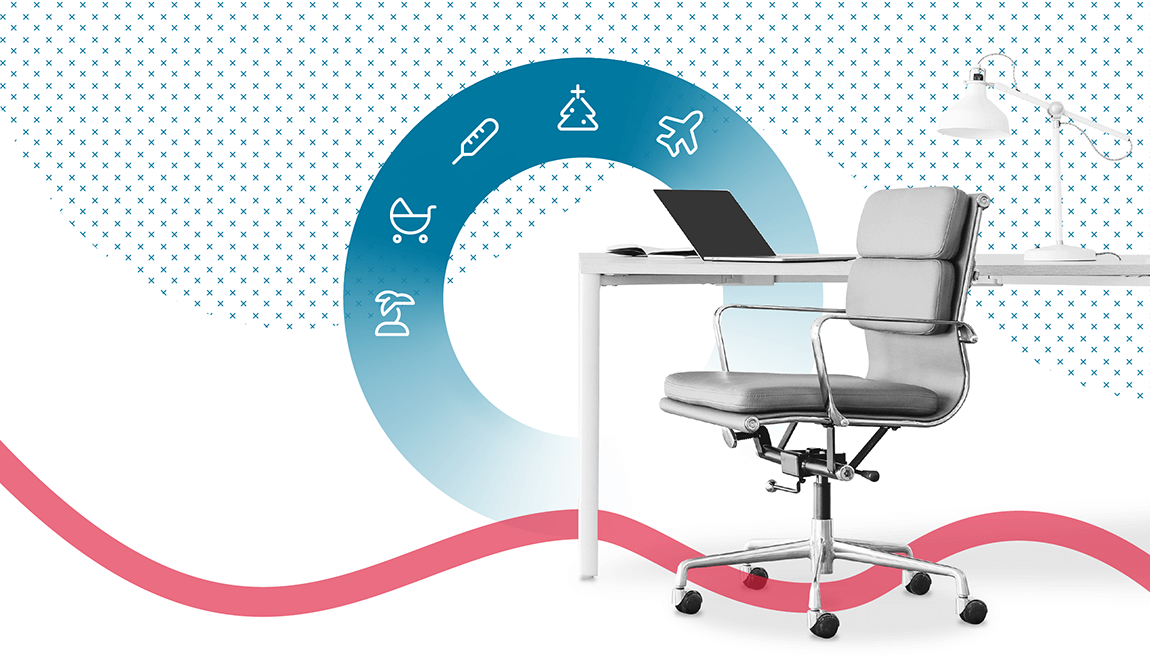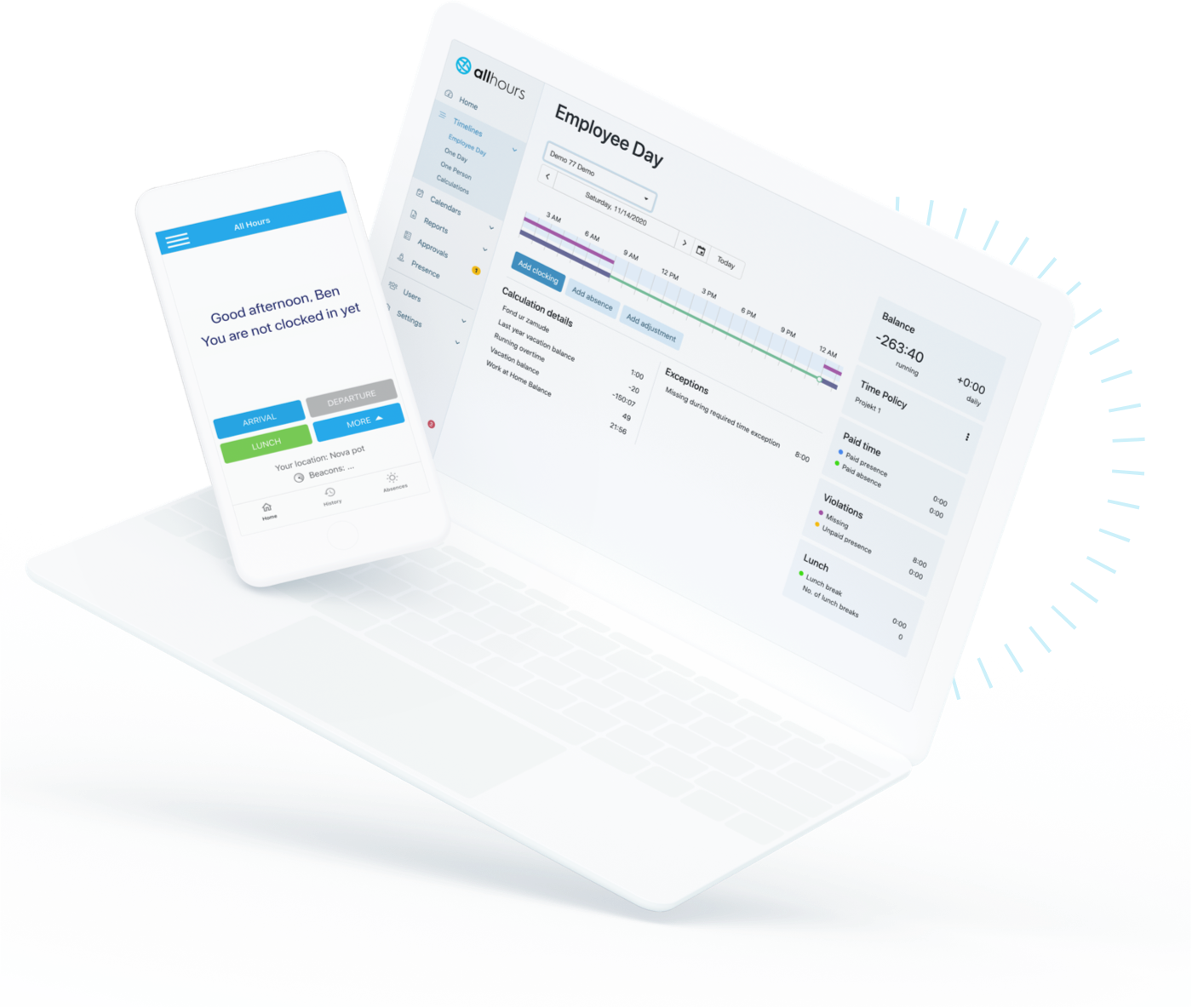The different types of leave and how to track them

No employee can be present each and every working day at their job. We humans are not robots. From vacations to sickness, to holiday days and personal reasons, there are many types of leave from work.
It’s important for employers to know what they are for the purpose of creating a sound leave policy and setting up tracking of when, namely for how long, and for what reason an employee was absent.
In this article we’ll look at the main types of leave (most of these should be included in a company’s leave policy), and how to manage and track absences. At the end, we’ll also look at a few ideas on how to lower absenteeism at the workplace.
- The 8 main different types of leave
- 1. Sick leave
- 2. Holiday leave
- 3. Maternity and paternity leave
- 4. Public and religious holidays
- 5. Bereavement leave
- 6. Time off in lieu (TOIL)
- 7. Sabbatical leave
- 8. Unpaid leave
- Other less common types of leave
- Company leave policy
- Tracking different types of leave
- Lowering absenteeism from work
The 8 main different types of leave
In general, different types of leave can be divided into voluntary, involuntary, paid, and unpaid leave.
Voluntary leave is when an employee plans an absence from work, such as going on holidays. Involuntary leave is when an employee can’t work due to medical reasons, a death in the family, etc.
Some forms of leave are paid by the employer, some by the government, and others are the burden of the employee.
Each country has its own legislation that sets minimum boundaries as to what types of leave and how many days are covered by an employee, and what is covered by the government.
The differences among countries, for example regarding paid holiday time, can be quite big. Next to that, each company has a leave policy or defines in each employment contract how absences from work are managed, and these policies can be quite different from company to company.
1. Sick leave
As the name implies, sick leave occurs when an employee gets ill and needs time to recover. In addition, many times isolation is required to prevent the spread of the illness, as we know very well from the recent COVID-19 situation.
How sick leave is managed is determined by legislation in most countries. An employer must provide a certain amount of paid sick leave to an employee, and in some countries depending on the amount of sick leave required and the severity of the illness, the government compensates part of the costs.
In certain nations, employees feel awkward asking for sick leave. But that can be a sign of a toxic company culture. In the long term, that can have huge health consequences and lead to burnout or lower productivity.
On the other hand, pretending to be sick is a serious violation of company policy.
2. Holiday leave
Holiday leave is when an employee takes time off for a personal vacation, be it traveling, family events, or rest in general.
Most companies have a strict policy on how much paid and unpaid holiday leave an employee can take per year, as well as when and the process for leave approval. Many countries have legislation that defines the minimum amount of holiday leave per year.
Especially among younger employees, sufficient free time and a good work-life balance are an important part of the compensation package.
Sometimes employees are prepared to take a lower pay check, in return for more free time and the ability to work remotely.
Thus, it’s important for each company to have a clearly defined vacation-leave policy that is transparent and fair to the employees. Besides salary, the number of (paid) vacation days is one of the most frequent variables in the employment negotiation process.
3. Maternity and paternity leave
Maternity leave is one of the most important types of leave in order for the mother to recover from delivery and take care of the new-born baby.
There are significant differences between countries in terms of how many weeks a mother gets for maternity leave, and what’s covered by the government.
EU countries have the longest paid maternity leave (from 16 to 85 weeks), whereas the US and Australia have quite a small amount of paid maternity leave.
We must also not forget paternity leave, which is designed for new fathers to spend time with the baby and support the mother in the first weeks. Paternity leave is usually much shorter, from 1 to 2 weeks, and is mandatory in some countries, while others leave it up to each company to decide.
4. Public and religious holidays
Each country has different public holidays; some of them are state related while others are religious. Some of these holidays are even celebrated in many countries on the same day.
A few examples of such holidays are:
- Christmas,
- New Year’s Day,
- Good Friday,
- Easter Monday,
- Labor Day, and so on.
In a sense, public holidays are days off provided by the government.
It’s important to mark each of your country’s days off at the beginning of the year in the company calendar and plan shifts accordingly. You can also track public and religious holidays in a time and attendance app.
5. Bereavement leave
Bereavement leave is for cases when an employee loses a loved one. It’s time off meant for grieving, taking care of the funeral, and the other responsibilities which come when someone dies.
Most often, companies approve from one to several days of bereavement leave for their employees. In some countries, bereavement leave is mandatory, and in others it is not.
6. Time off in lieu (TOIL)
TOIL, or compensatory leave is connected to working overtime. Just as a company should have a leave policy, so too should an overtime policy be in place.
Overtime should also be properly managed with overtime-management software. Keeping this in mind, some companies enable employees to work overtime, after which they are compensated with days off.
7. Sabbatical leave
Sabbatical leave is quite popular in academia, and basically means taking a longer break from work, usually for several months.
Most often, employees take sabbaticals to fulfil their other interests, passions, or hobbies (for example to travel the world, study a new subject, etc.) and sometimes to completely recover from longer periods of stressful work. A sabbatical usually lasts from 6 to 12 months.
Oftentimes, companies give the option of a sabbatical for employees who have worked at the organization for a longer period as a reward for their loyalty and the good work they have done in the past.
Some companies offer paid or partly-paid sabbatical leave, and others only offer the option of unpaid sabbatical leave.
8. Unpaid leave
Some companies enable employees to take unpaid leave, meaning that the absence comes with a pay cut.
That’s usually strictly defined in the organization’s leave policy, including how many unpaid days an employee can take, when, what the approval procedure is, and how that influences payment.
That comes is especially handy for employees who prefer more free time over a bigger pay check.
Other less common types of leave
Besides the main types of leave described above, we are also aware of several other possibilities. These kinds of leave are less common and are not always defined in the company’s leave policy.
Nevertheless, it’s good to be aware of them:
- Study
- Military leave
- Jury duty / Leave to give testimony as a witness in court
- Election day
- Time off for volunteer work and blood donation
- Time off for protests
- Adverse weather leave
- Gardening leave when somebody quits their job
Company leave policy
A leave policy is a company’s internal document, which defines how absences from work are managed. Usually, in a leave policy the following things are defined:
- The type of leave an employee is eligible to
- The amount of paid leave an employee has
- How to apply for leave and what the approval procedure is
- Procedures and consequences in the case of a breach of leave policy
A leave policy is important for both employer and the employee, since it very clearly defines how absences are managed.
On the one hand, with a leave policy employees have insurance for the time off they deserve, and on the other, the employer can strictly define limits and consequences in cases of unapproved leave.
![]()
Tracking different types of leave
Once you have a clearly defined leave policy, it’s important to regularly track employees’ leave.
With a time and attendance solution such as SPICA All Hours, you can easily track when, for how long, and for what reasons an employee was absent. You can also approve absences and get detailed absence reports on the individual, team, or department levels.
A complete leave-management system comes with features such as:
- An interactive calendar for absence planning
- Features allowing employees to submit absence requests which can then be approved or denied through the app
- The ability to set up different rules for different employees
- A transparent history of approvals, so there can’t be miscommunication
- Features to easily track absences and get visual statistics
- Team holiday management
- Features to assure compliance with accruals
- The ability to track other types of work, such as remote work
With a cloud leave-management system, you can automate the process, reduce administration, and make absence approvals much faster and more transparent. You can test our leave management solution entirely for free.
Lowering absenteeism from work
Last but not least, let’s mention a few recommendations on how to lower absenteeism from work. We all need time off, and we can all get sick, but nevertheless, excessive absenteeism can be a big burden on a company’s productivity.
Company culture, leave policies, management styles, workload, and similar factors can have a great influence on how many days employees are absent from work, especially in the long term.
Here are some general recommendations to keep unhealthy absenteeism in check:
- Encourage healthy lifestyles and run corporate wellness programs, including company sport events, yoga classes during work, access to a gym, etc.
- Have healthy meals in the office
- Make sure you have zero tolerance towards bullying and harassment
- Encourage team work and good relationships among employees
- Keep work stress in moderation so that it promotes growth and not burnout
- Offer flexible work options, including remote work
- Show that you care about employees and provide support to employees in trouble
- As already mentioned, have a clear leave policy and transparent tracking which also includes sanctioning unapproved absences immediately
We’ve looked at the different types of leave, defined why they are important and how leave should be managed and tracked, and why each company should have a leave policy.
If you don’t have a clear leave-management policy in your company yet, we encourage you to define one and then implement a time & attendance solution such as SPICA All Hours to track the various types of leave and manage them properly.







